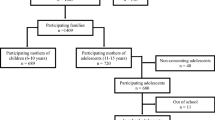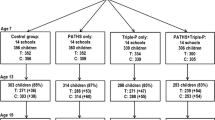Abstract
The purpose of this study was to test child and adolescent psychosocial and psychopathological risk factors as predictors of adult criminal outcomes in a Swiss community sample. In particular, the role of active and avoidant problem coping in youths was analysed. Prevalence rates of young adult crime convictions based on register data were calculated. Univariate and multivariate logistic regressions were used to analyse the prediction of adult criminal convictions 15 years after assessment in a large Swiss community sample of children and adolescents (n = 1,086). Risk factors assessed in childhood and adolescence included socio-economic status (SES), migration background, perceived parental behaviour, familial and other social stressors, coping styles, externalizing and internalizing problems and drug abuse including problematic alcohol consumption. The rate of any young adult conviction was 10.1 %. Besides externalizing problems and problematic alcohol consumption, the presence of any criminal conviction in young adulthood was predicted by low SES and avoidant coping even after controlling for the effects of externalizing problems and problematic alcohol use. The other predictors were significant only when externalizing behaviours and problematic alcohol use were not controlled. In addition to child and adolescent externalizing behaviour problems and substance use, low SES and inadequate problem-solving skills, in terms of avoidant coping, are major risk factors of young adult criminal outcomes and need to be considered in forensic research and criminal prevention programs.
Similar content being viewed by others
References
Achenbach TM (1991) Manual for the Youth Self Report and 1991 Profile. Department of Psychiatry, University of Vermont, Burlington, VT
Agnew R (1992) Foundation of a general strain theory of crime and delinquency. Criminology 30:47–88
Baer PE, Garmezy LB, McLaughlin RJ, Pokorny AD, Wernick MJ (1987) Stress, coping, family conflict, and adolescent alcohol use. J Behav Med 10:449–466
Boisjoli R, Vitaro F, Lacourse E, Barker ED, Tremblay RE (2007) Impact and clinical significance of a preventive intervention for disruptive boys: 15-year follow-up. Br J Psychiatry 191:415–419
Brook JS, Zhang C, Brook DW (2011) Antisocial behavior at age 37: developmental trajectories of marijuana use extending from adolescence to adulthood. Am J Addict 20:509–515
Caprara GV, Cinanni V, D’Imperio G, Passerini S, Renzi P, Travaglia G (1985) Indicators of impulsive aggression: present status of research on irritability and emotional susceptibility scales. Pers Indiv Differ 6:665–674
Chung HL, Steinberg L (2006) Relations between neighborhood factors, parenting behaviors, peer deviance, and delinquency among serious juvenile offenders. Dev Psychol 42:319–331
Cleary A, Nixon E (2011) Early adult outcomes for Irish children with behavioural difficulties. Int J Soc Psychiatry. doi:10.1177/0020764011421100
Compas BE, Connor-Smith JK, Saltzman H, Thomsen AH, Wadsworth ME (2001) Coping with stress during childhood and adolescence: problems, progress, and potential in theory and research. Psychol Bull 127:87–127
Copeland WE, Miller-Johnson S, Keeler G, Angold A, Costello EJ (2007) Childhood psychiatric disorders and young adult crime: a prospective, population-based study. Am J Psychiatry 164:1668–1675
Dekovic M, Slagt MI, Asscher JJ, Boendermaker L, Eichelsheim VI, Prinzie P (2011) Effects of early prevention programs on adult criminal offending: a meta-analysis. Clin Psychol Rev 31:532–544
Eftekhari A, Turner AP, Larimer ME (2004) Anger expression, coping, and substance use in adolescent offenders. Addict Behav 29:1001–1008
Elonheimo H, Sourander A, Niemela S, Helenius H (2011) Generic and crime type specific correlates of youth crime: a Finnish population-based study. Soc Psychiatry Psychiatr Epidemiol 46:903–914
Farrington DP (2000) Psychosocial predictors of adult antisocial personality and adult convictions. Behav Sci Law 18:605–622
Farrington DP (1995) The Twelfth Jack Tizard Memorial Lecture. The development of offending and antisocial behaviour from childhood: key findings from the Cambridge study in delinquent development. J Child Psychol Psychiatry 36:929–964
Fergusson DM, Horwood LJ, Ridder EM (2005) Show me the child at seven: the consequences of conduct problems in childhood for psychosocial functioning in adulthood. J Child Psychol Psychiatry 46:837–849
Ford JD, Racusin R, Ellis CG, Daviss WB, Reiser J, Fleischer A, Thomas J (2000) Child maltreatment, other trauma exposure, and posttraumatic symptomatology among children with oppositional defiant and attention deficit hyperactivity disorders. Child Maltreat 5:205–217
Gibb SJ, Fergusson DM, Horwood LJ (2012) Childhood family income and life outcomes in adulthood: findings from a 30-year longitudinal study in New Zealand. Soc Sci Med 74:1979–1986
Granic I, Patterson GR (2006) Toward a comprehensive model of antisocial development: a dynamic systems approach. Psychol Rev 113:101–131
Hasking PA (2007) Reinforcement sensitivity, coping, and delinquent behaviour in adolescents. J Adolesc 30:739–749
Hodgins S, Larm P, Molero-Samuleson Y, Tengstrom A, Larsson A (2009) Multiple adverse outcomes over 30 years following adolescent substance misuse treatment. Acta Psychiatr Scand 119:484–493
Huesman LR, Eron LD, Dubow EF (2002) Childhood predictors of adult criminality: are all risk factors reflected in childhood aggressiveness? Crim Behav Ment Health 12:195–208
Kandel DB (1982) Epidemiological and psychosocial perspectives on adolescent drug use. J Am Acad Child Adolesc Psychiatry 21:328–347
Killias M (2009) Paradise lost? New trends in crime and migration in Switzerland. Soc Crime Law Deviance 13:33–45
Kort-Butler LA (2009) Coping styles and sex differences in depressive symptoms and delinquent behavior. J Youth Adolesc 38:122–136
Lazarus RS, Folkman S (1984) Stress, appraisal, and coping. Springer, New York
Leigh BC (1999) Peril, chance, adventure: concepts of risk, alcohol use and risky behavior in young adults. Addiction 94:371–383
Martin SE (2001) The links between alcohol, crime and the criminal justice system: explanations, evidence and interventions. Am J Addict 10:136–158
Mason WA, Kosterman R, Hawkins JD, Herrenkohl TI, Lengua LJ, McCauley E (2004) Predicting depression, social phobia, and violence in early adulthood from childhood behavior problems. J Am Acad Child Adolesc Psychiatry 43:307–315
McMurran M, Fyffe S, McCorath L, Duggan C, Latham A (2001) ‘Stop & Think!’: social problem solving therapy with personality disordered offenders. Crim Behav Ment Health 11:273–285
Moffitt TE (1993) Adolescence-limited and life-course-persistent antisocial behavior: a developmental taxonomy. Psychol Rev 100:674–701
Moffitt TE, Caspi A (2001) Childhood predictors differentiate life-course persistent and adolescence-limited antisocial pathways among males and females. Dev Psychopathol 13:355–375
Mueller R, Abbet JP (1991) Changing trends in the consumption of legal and illegal drugs by 11–16-year-old adolescent pupils. Findings from a study conducted under auspices of the World Health Organisation. Swiss Professional Service for Alcohol Problems, Lausanne
Myers R (1990) Classical and modern regression with applications. Duxbury, Boston
Nagin D, Tremblay RE (1999) Trajectories of boys’ physical aggression, opposition, and hyperactivity on the path to physically violent and nonviolent juvenile delinquency. Child Dev 70:1181–1196
Odgers CL, Moffitt TE, Broadbent JM, Dickson N, Hancox RJ, Harrington H, Poulton R, Sears MR, Thomson WM, Caspi A (2008) Female and male antisocial trajectories: from childhood origins to adult outcomes. Dev Psychopathol 20:673–716
Plattner B, Aebi M, Steinhausen HC, Bessler C (2011) Psychopathological and comorbid disorders of incarcerated adolescents in Austria. Z Kinder Jug Psych 39:231–240
Plattner B, Giger J, Bachmann F, Brühwiler K, Steiner H, Steinhausen HC, Bessler C, Aebi M (2012) Psychopathology and offense types in detained male juveniles. Psychiatry Res 198:285–290
Reef J, Donker AG, Van Meurs I, Verhulst F, Van der Ende J (2011) Predicting adult violent delinquency: gender differences regarding the role of childhood behaviour. Eur. J. Criminol 8:187–197
Reitzle M, Winkler Metzke C, Steinhausen HC (2001) Parents and children: the Zurich brief questionnaire for the assessment of parental behaviors. Diagnostica 47:196–207
Robinson D, Porporino FJ (2004) Programming in cognitive skills: the reasoning and rehabilitation programme. In: Hollin CR (ed) The essential handbook of offender assessment and treatment. Wiley, Sussex (UK), pp 63–78
Ruchkin VV, Eisemann M, Hägglöf B (1999) Coping styles in delinquent adolescents and controls: the role of personality and parental rearing. J Youth Adolesc 28:705–717
Seiffge-Krenke I (1989) Coping with everyday problem situations: a coping questionnaire for adolescents. Z Diff Diagn Psychol 10:201–220
Sourander A, Elonheimo H, Niemelä S, Nuutila A-M, Helenius H, Sillanmäki L, Piha J, Tamminen T, Kumpulainen K, Moilanen I, Almqvist F (2006) Childhood predictors of male criminality: a prospective population-based follow-up study from age 8 to late adolescence. J Am Acad Child Adolesc Psychiatry 45:578–586
Steinhausen HC, Meier M, Angst J (1998) The Zurich long-term outcome study of child and adolescent psychiatric disorders in males. Psychol Med 28:375–383
Steinhausen HC, Winkler Metzke C (2001) Risk, compensatory, vulnerability, and protective factors influencing mental health in adolescence. J Youth Adolesc 30:259–280
Steinhausen HC, Winkler Metzke C (2003) The validity of adolescent types of alcohol use. J Child Psychol Psychiatry 44:677–686
Steinhausen HC, Winkler Metzke C (2001) The Zurich life event list: results from a Swiss epidemiological study. Kindh Entwickl 10:47–55
Steinhausen HC, Winkler Metzke C, Kannenberg R (1999) A questionnaire for adolescents: The Zurich results of the Youth Self Report. University of Zurich, Department of Child and Adolescent Psychiatry, Zurich
Steinhausen HC, Winkler Metzke C, Meier M, Kannenberg R (1997) Behavioral and emotional problems reported by parents for ages 6 to 17 in a Swiss epidemiological study. Eur Child Adolesc Psychiatry 6:136–141
Stouthamer-Loeber M, Wei E, Loeber R, Masten AS (2004) Desistance from persistent serious delinquency in the transition to adulthood. Dev Psychopathol 16:897–918
Stringaris A, Cohen P, Pine DS, Leibenluft E (2009) Adult outcomes of youth irritability: a 20-year prospective community-based study. Am J Psychiatry 166:1048–1054
Swiss Federal Institute for Statistics (1992) Swiss Health Survey http://www.bfs.admin.ch/bfs/portal/de/index/infothek/erhebungen__quellen/blank/blank/ess/01.html. Accessed 15 August 2012
Verhulst FC, van der Ende J (1992) Agreement between parents’ reports and adolescents’ self-reports of problem behavior. J Child Psychol Psychiatry 33:1011–1023
Winkler Metzke C, Steinhausen HC (2002) Coping strategies in adolescence. Z Entwickl Padagogis Psychol 34:216–226
Zurich Police Department (1995) Criminal statistics of the Canton Zurich 1994. Canton Zurich, Zurich
Acknowledgments
This contribution is a continuation of the Zurich Adolescent Psychology and Psychopathological Study (ZAPPS) which, in earlier phases, had been supported by the Swiss Science Foundation and the Johann Jacobs Foundation with HCS as the principal investigator.
Conflict of interest
The authors declare that they have no conflicts of interest.
Author information
Authors and Affiliations
Corresponding author
Rights and permissions
About this article
Cite this article
Aebi, M., Giger, J., Plattner, B. et al. Problem coping skills, psychosocial adversities and mental health problems in children and adolescents as predictors of criminal outcomes in young adulthood. Eur Child Adolesc Psychiatry 23, 283–293 (2014). https://doi.org/10.1007/s00787-013-0458-y
Received:
Accepted:
Published:
Issue Date:
DOI: https://doi.org/10.1007/s00787-013-0458-y




